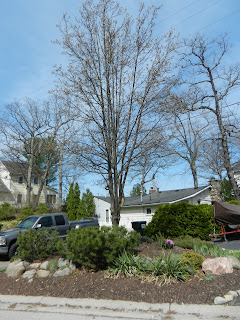 |
| Rue Anenome (Thalictrum thalictroides) |
I am sharing a list of what I planted in this bed with you all because part of it is in dry shade and the other part is in dry sun. These are challenging conditions that some of you may find on your own property. Perhaps my plant list could be of use to you.
 |
| Front garden BEFORE makeover, front view |
Luckily, I was able to take a couple days off of work, which I used to re-do the bed. I topped the soil with compost and shredded leaf mulch to help improve the moisture retention of the soil a bit. I added some stepping stones. I also had planted some of the deciduous bushes last fall.
I pruned some of the older juniper bushes to re-shape them and make room for other plants. I also pruned the lower branches of the bradford pear to allow more light in to the area.
I tried to choose plants that would survive the conditions well and would show nicely in the shade. I chose varieties with contrasting leaf colors in yellows, shades of green and white, and even a few with purple leaves with contrasting textures. For example, the bleeding heart has delicate golden leaves, the hosta have wide green/white leaves, the joe pye has medium-sized purple leaves, and the jacob's ladder has ferny blue-green leaves with white stripes. Hopefully they will look good even when not in bloom.
 |
| Front garden AFTER make-over, side view. |
hyacinths (pink, early spring bloom),
daffodils (yellow, early spring bloom),
red valerian (red, spring bloom),
dianthus (pink, spring bloom),
iris (dark purple, late spring bloom),
lilies (orange,late spring bloom ),
prickly pear (yellow, late spring bloom),
evening primrose (yellow, late spring bloom),
daylilies (orange & yellow, spring-summer bloom),
potentilla (yellow, late spring-fall bloom),
catmint (purple/blue, late spring-fall bloom),
yarrow (yellow, summer bloom),
yucca (white, summer bloom),
bee balm (red, summer bloom),
blanket flower (yellow/orange/red, summer bloom),
geum (orange, summer bloom),
Joe Pye weed (white, late summer-fall bloom),
roses (pink, summer-fall bloom),
sedum (orange, late summer-fall bloom),
 |
| AFTER makeover. Please forgive neighbor's construction/fence. |
dwarf althea (pink, late summer-fall bloom),
hens & chicks,
bradford pear,
scotch pine bushes,
and juniper.
In the dry shade I planted:
helebores (white & pink, early spring bloom),
daffodils (yellow, early spring bloom),
Primrose (yellow/pink, early spring bloom),
columbine (pink, blue & yellow, early spring bloom),
 |
| Hosta, bleeding heart, columbine & gooseberries. |
bleeding heart (pink, spring bloom),
rue anenome (white, spring bloom),
wood poppy (yellow, spring bloom),
Jacob's ladder (purple/blue, spring bloom),
fritillaria (yellow, spring bloom),
Japanese wood poppy (blue, spring bloom),
lady's mantle(yellow, late spring bloom),
climbing hydrangea (white, late spring bloom),
foxgloves (peachy orange, spring-summer bloom),
valerian (white, spring-summer bloom),
wood betony (purple/blue, late spring-summer bloom),
 |
| Columbine, wood poppy, foxgloves, and primrose. |
hardy geranium (purple/blue, summer-fall bloom),
cut leaf coneflower (yellow, late summer-fall bloom),
Japanese anenome/wind flower (pink, late summer-fall bloom),
ruby spice clethera (red/pink, summer bloom),
dryopterus fern,
and gooseberry bushes,
There is one small area of dimensions 10'x4' or so, off to the side of the garden, bordering my
Between the gooseberries & blueberries, I can get some food from this garden. With the perennials that I chose, I should have something in bloom there year round, as well. Some people would also use the valerian as a medicinal plant, but I plan to use it as a decorative perennial only. (Although, I did notice that valerian roots smell very sweet as I was planting it.)
I do expect to have to water the bed frequently, especially during the dry summer months. Watering will be particularly important this year as the plants get established.
I will try to remember to take an "update" photo of the garden later in the summer or perhaps next year when more of the flowers are in bloom. If I remember, I will add the photo to the end of this blog entry. Right now, the bed looks good, but it has only just been planted. So very few flowers are in bloom. I hope that it will improve with time.
Species Update:
I have continued to track the various species in my yard. Here is the update (continued from March):
Insects, spiders & "crawly" creatures:
33.Common Eastern Bumblebee (Bombus impatiens),
34. Honey Bee (seen to briefly to identify the exact species type),
35. Mosquitos (family Culcidae),
36. Fungus Gnats (family Mycetophilidae),
37. Midges (chironomidae)
38. Green Bottle Fly (Lucilia sericata),
39. Cellar Spider (Psilochorus pullulus),
40. Trashline Orb Weaver Spider (cyclosa),
41. Wolf Spider (Lycosoidea),
42. Earwig (forficula auricularia),
43. Cabbage White Butterfly (pieris rapae),
44. Earth Worm (Lumbricus terrestris),
45. Gray Field Slug (Deroceras reticulatum)
Mammals:
46. Cottontail Rabbit (Sylvilagus floridanus)
Birds:
47. Bank Swallow (Riparia riparia)
Also, the robins made a nest off my neighbor's back porch. Check it out:
Garden Marker Comparison Update:
Lastly, I have a brief update on the garden marker comparison: So far, the regular sharpie ink is fading, but only on the plastic and the metal garden markers. The other garden marker types are indistinguishable from each other as far as readability at this time. All types of ink and the pencil are standing strong on the wooden garden marker. I will give another brief update on this in 3 months time. I will do a full review, with photos, at the end of the year.
That's all for now, folks! I am looking forward to some warmer weather so that I can get the veggies in. I will update you all about this and my other gardening endeavors in a month!
As always: happy planting, dear reader! And a very happy spring!

